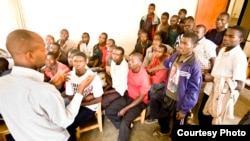Fifteen years ago, some 30 million people were infected with the deadly HIV/AIDS virus. Back then, most of them died of it.
What finally checked the rapid spread of the disease was the collective action of the global community. In 2002, the Global Fund to Fight AIDS, Tuberculosis (TB) and Malaria, an international institution that raises funds to support over 1000 anti-AIDS programs in more than 150 countries was formed; and, a year later, the U.S. President's Emergency Plan For AIDS Relief, or PEPFAR, was launched by then-President George W. Bush. Together, these initiatives constituted the two most effective mechanisms the world has ever had to combat AIDS.
Since those early days, we have made great headway against HIV/AIDS. The disease is no longer an automatic death sentence, as it was for most 15 years ago. Today, the once seemingly impossible dream of an AIDS-free society is within reach.
But it has become increasingly clear that to eliminate AIDS as a killer disease, we must also tackle two other major killers of people living with HIV/AIDS: TB and Malaria. Both diseases attack and kill people with weakened immune systems, such as individuals living with HIV/AIDS. In fact, TB is the leading cause of death among people living with HIV. And it is a curable disease, said Secretary of State John Kerry at the recent funding replenishment round for the Global Fund:
“With the right effort and the right focus, the right energy, we can eliminate it. But for that to happen, we need an innovative plan, a plan of attack for addressing the alarming increase in multidrug-resistant TB. We also need to develop new and more effective drugs and diagnostics. And we need to work together in order to prevent tuberculosis-related deaths by focusing on HIV/TB co-infections.”
No one program is going to stop AIDS or TB on its own. That is why the United States is very proud to be the largest donor in the battle against these two killers.
“Over the past decade, the United States has invested $48 billion in the battle against the three diseases, including $8.5 billion invested in the Global Fund,” said U.S. Ambassador to the United Nations, Samantha Power.
“These amounts reflect a commitment that transcends partisan politics in this country and that stretches across all sectors of American society.”
What finally checked the rapid spread of the disease was the collective action of the global community. In 2002, the Global Fund to Fight AIDS, Tuberculosis (TB) and Malaria, an international institution that raises funds to support over 1000 anti-AIDS programs in more than 150 countries was formed; and, a year later, the U.S. President's Emergency Plan For AIDS Relief, or PEPFAR, was launched by then-President George W. Bush. Together, these initiatives constituted the two most effective mechanisms the world has ever had to combat AIDS.
Since those early days, we have made great headway against HIV/AIDS. The disease is no longer an automatic death sentence, as it was for most 15 years ago. Today, the once seemingly impossible dream of an AIDS-free society is within reach.
But it has become increasingly clear that to eliminate AIDS as a killer disease, we must also tackle two other major killers of people living with HIV/AIDS: TB and Malaria. Both diseases attack and kill people with weakened immune systems, such as individuals living with HIV/AIDS. In fact, TB is the leading cause of death among people living with HIV. And it is a curable disease, said Secretary of State John Kerry at the recent funding replenishment round for the Global Fund:
“With the right effort and the right focus, the right energy, we can eliminate it. But for that to happen, we need an innovative plan, a plan of attack for addressing the alarming increase in multidrug-resistant TB. We also need to develop new and more effective drugs and diagnostics. And we need to work together in order to prevent tuberculosis-related deaths by focusing on HIV/TB co-infections.”
No one program is going to stop AIDS or TB on its own. That is why the United States is very proud to be the largest donor in the battle against these two killers.
“Over the past decade, the United States has invested $48 billion in the battle against the three diseases, including $8.5 billion invested in the Global Fund,” said U.S. Ambassador to the United Nations, Samantha Power.
“These amounts reflect a commitment that transcends partisan politics in this country and that stretches across all sectors of American society.”

















